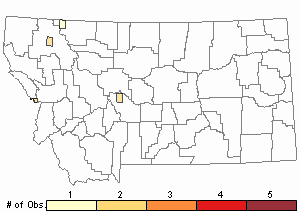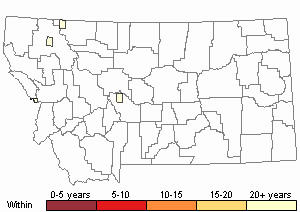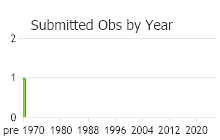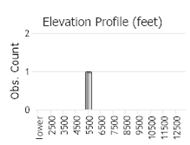View in other NatureServe Network Field Guides
NatureServe
Montana
Utah
Wyoming
Idaho
Wisconsin
British Columbia
South Carolina
Yukon
California
New York
Variable Dicranella Moss - Dicranella varia
Other Names:
Variable Fork Moss
General Description
Plants: Acrocarpous. Growing in pale or sordid green clumps of erect shoots, not glossy. Stems sometimes branched, 6-15 mm tall (Crum & Anderson et al., 1981).
Leaves: Spreading to ca 45 degrees or curved and pointing toward one side of the stem, lance-shaped, tapering to a very slender, lance-shaped and somewhat folded limb, the lower leaves ca 1 mm long, the upper ones reaching as much as 2 mm in length; apex obtuse or acute; margins narrowly- to scarcely-curved back and downward in parts of the lower margin, smooth except at the very tip, which is erratically toothed (Crum & Anderson et al., 1981); base not enveloping the stem (Lawton 1971); costa reaching the apex (Crum & Anderson et al., 1981).
Leaf Cells: Laminal cells reaching the leaf tip (Lawton 1971), smooth, not porose; lower laminal cells quadrangular and very slender; alar cells not distinct (FNA 2007); distal medial laminal cells long and thin; margins 2 cell-layers thick (Crum & Anderson et al., 1981); costa in X-section with an abaxial stereid band and 2-3 guide cells (Lawton 1971).
Phenology
Fruit ripens in spring (FNA 2007).
Diagnostic Characteristics
Given the shortness of the smooth capsule, the peristome is quite large (FNA 2007).
The recurvature of the margin is typically easier to observe at the shoulder (Crum & Anderson et al., 1981).
Range Comments
North American Range
Canada: YT, BC to NL and NS (except SK); USA: AK, most of the lower 48 states (except NV, UT, WY, SD, NM, AR, WI and ME); Mexico (FNA 2007). Known in Montana from Cascade, Flathead, Glacier, and Missoula Counties (Elliott 2016).
Observations in Montana Natural Heritage Program Database
Number of Observations: 7
(Click on the following maps and charts to see full sized version)
Map Help and Descriptions
Relative Density

Recency



 (Observations spanning multiple months or years are excluded from time charts)
(Observations spanning multiple months or years are excluded from time charts)
Habitat
Bare (Lawton 1971), moist, non-acidic soil in exposed, disrupted habitats, like channels along roads (FNA 2007). Elevations: low to ca 6560 feet (Lawton 1971).
Reproductive Characteristics
Dioicous. Perichaetial leaves somewhat enveloping the stem, to 3 mm in length (Lawton 1971). Male and female plants similar in size. Seta single, spiraled when dry, 5-16 mm tall, light red to yellow with red tones, turning darker with age. Capsule upright, tilted, but most often level, smooth, constricted beneath the opening, 0.7-1 mm in length; peristome single (FNA 2007), 0.3-0.35 mm (Lawton 1971), with 16 teeth, the teeth red, papillose distally, lined or pitted proximally, 2-lobed with the distal split reaching ca 1/3 down. Calyptra hood-like, concealing ca 1/2 of the capsule, falling away when the capsule ripens (FNA 2007).
Stewardship Responsibility
References
- Literature Cited AboveLegend:
 View Online Publication
View Online Publication Crum, H.A. and L.E. Anderson. 1981. Mosses of Eastern North America. 2 volumes. Columbia University Press, New York. 1328 pp.
Crum, H.A. and L.E. Anderson. 1981. Mosses of Eastern North America. 2 volumes. Columbia University Press, New York. 1328 pp. Elliott, J.C. and A.K. Pipp. 2018. A Checklist of Montana Mosses (1880-2018). Updated 3 January, 2020. Montana Natural Heritage Program, Helena, Montana. 73 pp.
Elliott, J.C. and A.K. Pipp. 2018. A Checklist of Montana Mosses (1880-2018). Updated 3 January, 2020. Montana Natural Heritage Program, Helena, Montana. 73 pp. Flora of North America Editorial Committee, eds. 2007. Flora of North America North of Mexico. Volume 27. Bryophytes: Mosses, Part 1. Oxford University Press, Inc., NY. xxi + 713 pp.
Flora of North America Editorial Committee, eds. 2007. Flora of North America North of Mexico. Volume 27. Bryophytes: Mosses, Part 1. Oxford University Press, Inc., NY. xxi + 713 pp. Lawton, E. 1971. Moss Flora of the Pacific Northwest. Hattori Botanical Laboratory. Japan: Yamabuki-cho, Shinjuku-ku, Tokyo. 362 pages plus appendices.
Lawton, E. 1971. Moss Flora of the Pacific Northwest. Hattori Botanical Laboratory. Japan: Yamabuki-cho, Shinjuku-ku, Tokyo. 362 pages plus appendices.
- Additional ReferencesLegend:
 View Online Publication
View Online Publication
Do you know of a citation we're missing? Elliot, J. C. 1993. Second checklist of Montana mosses. Unpublished report. U.S. Forest Service, Region 1. Missoula, MT. 45 pp.
Elliot, J. C. 1993. Second checklist of Montana mosses. Unpublished report. U.S. Forest Service, Region 1. Missoula, MT. 45 pp. Lawton, E. 1971. Keys for the Identification of the Mosses on the Pacific Northwest. Reprinted from 'Moss Flora of the Pacific Northwest'. Published as Supplement No. 2 of the Journal of the Hattori Botanical Laboratory. Nichinan, Miyazaki, Japan. 66 pp.
Lawton, E. 1971. Keys for the Identification of the Mosses on the Pacific Northwest. Reprinted from 'Moss Flora of the Pacific Northwest'. Published as Supplement No. 2 of the Journal of the Hattori Botanical Laboratory. Nichinan, Miyazaki, Japan. 66 pp. Malcolm, B., N. Malcolm, J. Shevock, and D. Norris. 2009. California Mosses. Nelson, New Zealand: Micro-Optics Press. 430 pp.
Malcolm, B., N. Malcolm, J. Shevock, and D. Norris. 2009. California Mosses. Nelson, New Zealand: Micro-Optics Press. 430 pp. Smith, A.J.E. 1980. The Moss Flora of Britain and Ireland. Cambridge University Press, Cambridge. 705 pp.
Smith, A.J.E. 1980. The Moss Flora of Britain and Ireland. Cambridge University Press, Cambridge. 705 pp. Vitt, D. J. Marsh, and R. Bovey. 1988. Mosses, Lichens & Ferns of Northwest North America. Seattle, WA: University of Washington Press. 296 p.
Vitt, D. J. Marsh, and R. Bovey. 1988. Mosses, Lichens & Ferns of Northwest North America. Seattle, WA: University of Washington Press. 296 p.
- Web Search Engines for Articles on "Variable Dicranella Moss"





